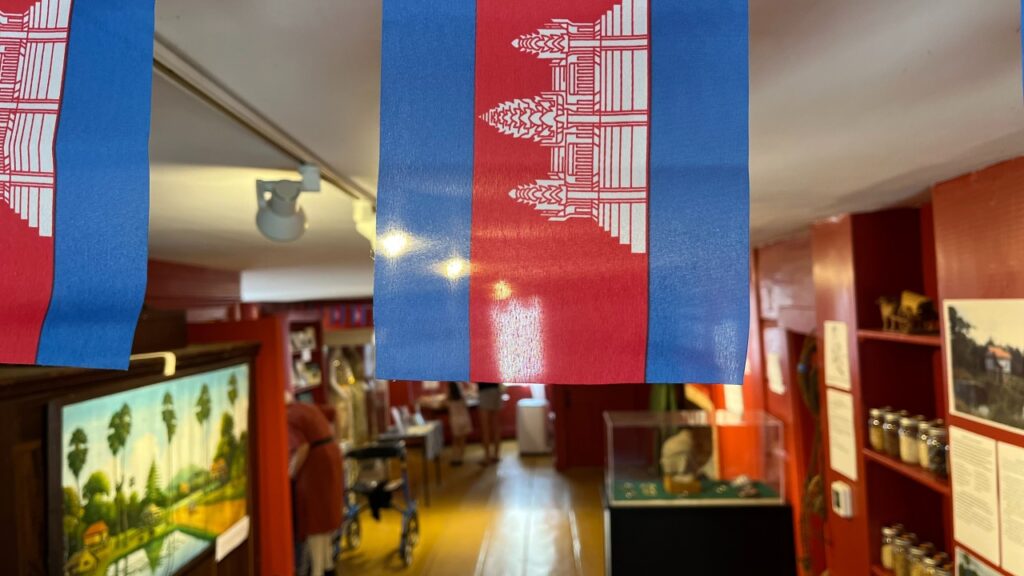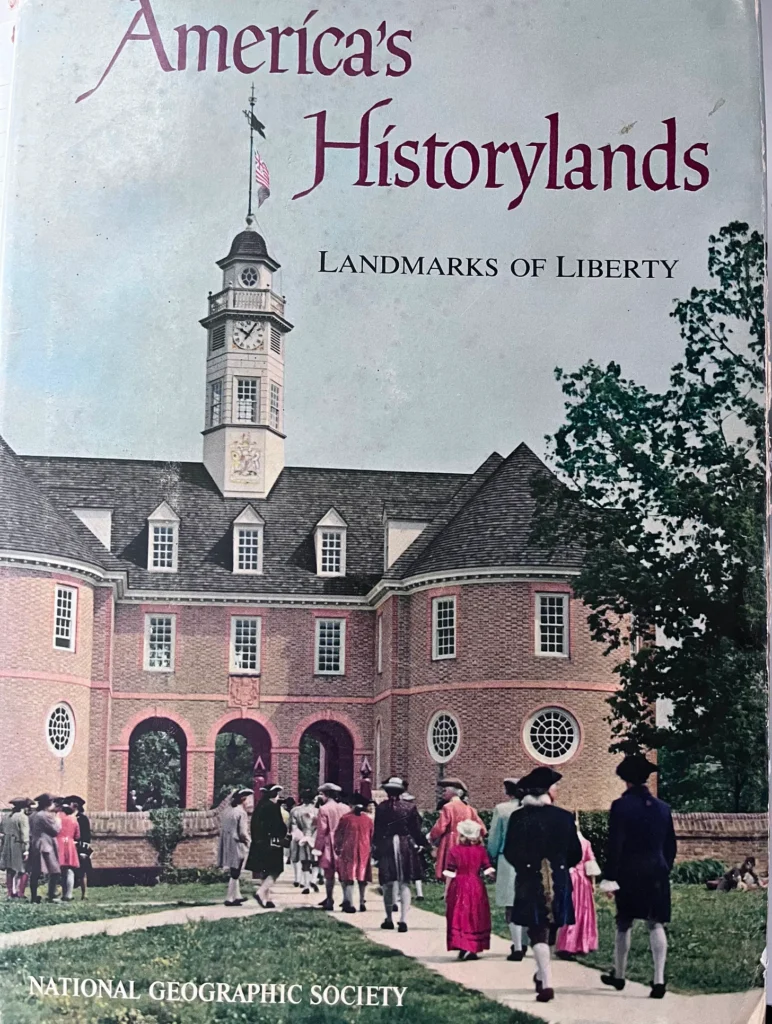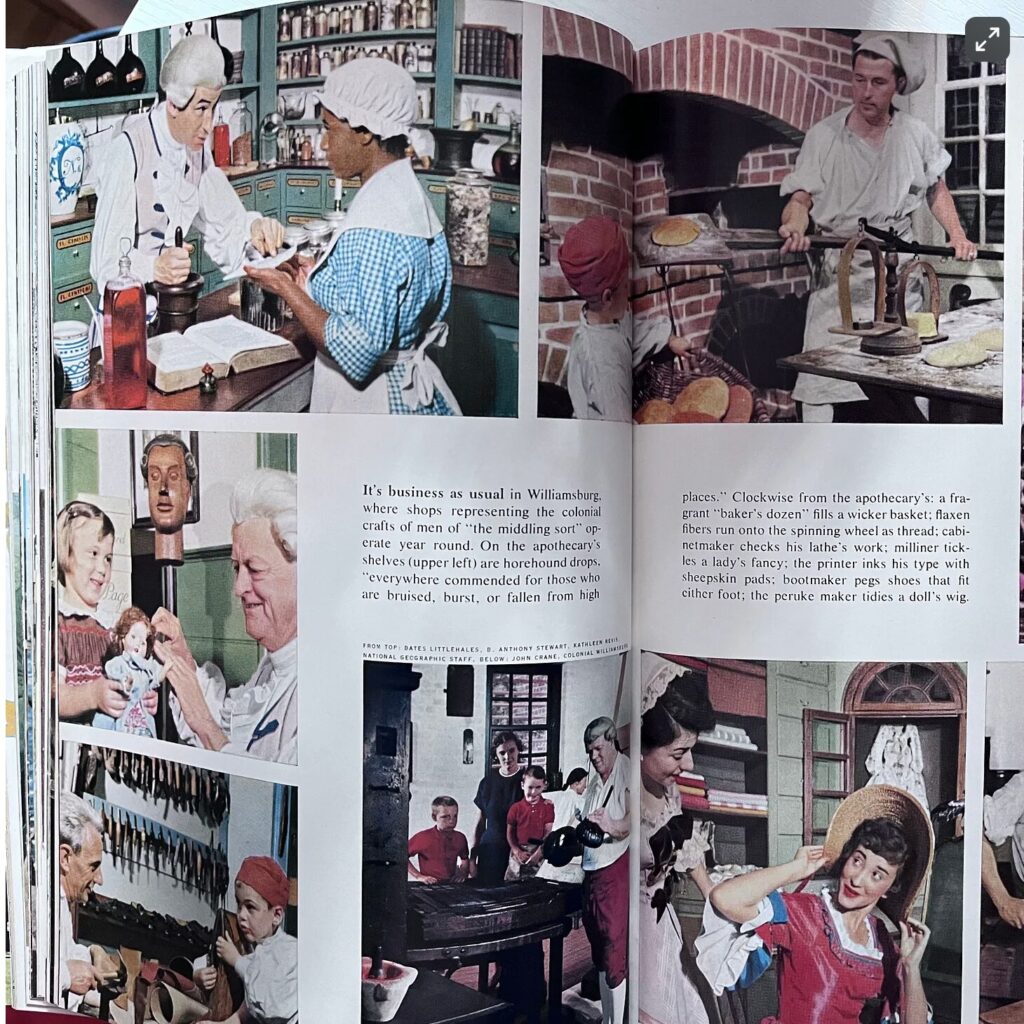Resettling Our History Lands. Reflections on the Exhibit “Cambodians in Amherst”

From the exhibit, Cambodians in Amherst at the Amherst History Museum. Photo: Brian Boyles
This article appeared originally under the title Resettling Our History Lands and was posted to the Substack and Linked In accounts of the author.. It is reposted here with permission.
“A vigorous and growing nation such as ours must preserve its historic heritage and pass it on to succeeding generations. This heritage tells the story of America’s growths, trials, accomplishments, and goals. It provides the key to understanding the present and planning wisely for the future.” –Conrad Wirth, Director, National Park Service, 1962. From the introduction to America’s Historylands.
“Learning in their own language makes the students more confident. We create books using stories and drawings from Cambodia to teach reading. I want them to remember their country.” –Thiem Ung, 1989. Cambodians in Amherst exhibit.
I live in a small town with a very cool transfer station. A transfer station is, essentially, a recycling center where residents can deposit cardboard, plastics, and compost in assigned bins. Our transfer station is more than that, though. It’s a social scene, a sort of forest town common with dumpsters and a collection of freestanding huts, each dedicated to old toys, used clothes, redeemables and “take it or leave it.” Many of us see it as a highlight of local life.
The well-organized book stall reflects our location amidst the Five Colleges. On any given Sunday, you can pick up Ta-Nehisi Coates, a guide to Cajun country, and Annie Dillard (this happened one afternoon in June). Never have I so looked forward to taking out the trash.
Last Saturday, I plucked out a slightly mildewed volume from the National Geographic Society. America’s Historylands: Landmarks of Liberty declares itself “the most important book ever published” by the society.

We often hear of current movements to “whitewash” classrooms and books. Advocates for these efforts declare their opposition to “woke” history, to any revisionism that seeks to make Americans feel bad about our nation. Tell the positive, they cry.
Historylands does just that. This is as close as we might come to an official post-WWII narrative, distributed by one of the most trusted purveyors of 20th century popular histories. Released in 1962, the book runs 572 pages and features 676 illustrations, including 38 maps, and many color photos of reenactors at sites including Salem, Williamsburg, and Plymouth. Historylands seeks to “capture the heart, spirit, and stirring traditions of America in terms of the places where the great events occurred.”
In this telling, America begins with the arrival of Columbus, whose “sailors sniffed appreciatively” as they dropped anchor at San Salvador. The unfolding chapters trace the ensuing 400 years, at the end of which “no region of North America had missed the white man’s tread.
“And what did he do with his discoveries? That is the theme of this book.”
This is true in only the most exclusive of ways. We meet the Pilgrims without their violence. In Virginia, “astride a finely bred horse, the planter directed the overseers of slaves in the fields, the blacksmith, the cobbler.” He traded his bounty for fine furniture and education for his children. “Between times, he read well.”

We follow the battlefields of the Civil War (a conflict featuring no 54th Regiments, no Frederick Douglass) with a quick frolic through the “Lusty West,” a place of “Indians, sodbusters, cattlemen, forty-niners—men with the west in their eyes!” Alas, “Indian and White Man were destined to clash.” We take tours of the great homes of Vanderbilt and Ford. The final illustration, a photo of a rocket launching, follows a page describing “the wizadry of Oak Ridge.”
The first print run of Historylands produced 200,000 copies. These were the stories my parents learned in public school. This is quite literally what we mean when we speak of the “marginalization” of Indigenous people and enslaved Africans from texts. This is the American history that reared the Baby Boomers, that flowed through those yellow-bordered magazines, that shaped the national identity for millions of Americans.
I found it, of course, in the trash. For many reasons, we don’t create or cherish books like this today. No one needs an encyclopedic volume because…the internet. Thankfully, the work of scholars, journalists and activists toppled these smug narratives. Minor and quotidian as it is, Historylands is a miniature monument that belongs in the dust bin.
But I think there’s another set of urgent questions: What replaces this version of the past? What places and people do we uplift for “understanding the present and planning wisely for the future?” Who creates our next history? How?
Five miles from the transfer station, I visited one possible answer.
The Amherst Historical Society (AHS) is located in the 1750-era Simeon Strong House in the town center. Tan with brown trim, the two-story building is compact and well-preserved. Inside, the low-ceilinged rooms are familiar to anyone who’s visited a historical society, with glass cases and shelves well-suited for the display of farming tools and old photos. The artifacts that fill the space today, however, come from more recent times.
For some people, a historical society looks and smells a lot like Historylands. Fortunately, Massachusetts is full of organizations with leaders, curators, and volunteers determined to counter that assumption with new approaches to public history.
Which makes AHS’s newest exhibition, “Cambodians in Amherst: The history of the Khmer Community”, important and worth seeing. Supported through Mass Humanities’ Expand Mass. Stories initiative, the exhibit chronicles a formative period in the Commonwealth’s history.
“In the early 1980’s members of the Amherst community organized to give refuge to survivors of the Khmer Rouge genocide in Cambodia. Faith communities and their partners helped many Cambodian families escape the desperate circumstances they faced in refugee camps in Southeast Asia and resettle in Amherst. This exhibit tells the story of the courage and compassion of both communities, the journeys they took rebuild lives destroyed by war and genocide, and the positive effects they had on the people and the town of Amherst.”
How we create our histories is just as important as what we create. In Amherst, “Cambodian students of Amherst Regional High School interviewed the Cambodian elders, teachers, and Amherst communitiy members to capture their stories.” The students were assisted by former teachers from the high school as they collected memories of refugee camps and resettlment.
These stories, available at laptop stations, on video screens, and in the wall text, give us the firsthand experiences of people who lived before, during, and after the catastrophe of Pol Pot’s regime.
Among the featured artificats are applications for asylum; certificates of completion for cultural oriention classes at a processing center in the Phillipines; nametags worn by people as they traveled to the U.S.; and the bags they received to carry their belongings.
On one wall hang two winter coats, an adult’s and a child’s, provided for people experiencing their first North American winters. Faith-based communities including the Mount Toby Friends Meeting, Immanuel Lutheran Church, and North Congregational Church, helped to resettle the first families.
“Since each church had a large committee of volunteers, in Amherst alone hundreds of people were helping Khmer families with housing, shopping, jobs, health care, learning English, dealing with schools, as well as the challenges of tracing lost family members and managing immigration paperwork.”
Once settled, Cambodian people advocated for themselves and their communities. The devastation of war lived on in the New England college town. We read about Lauren (Ren) Mouen and Heap Sin, who worked for the Amherst Health Department to serve elders who, decades after resettlement, continued to suffer from “high rates of diabetes, unhealed injuries, sleeping disorders, PTSD and depression.”
The skills of Khmer growers blossomed in western Mass, first behind apartment buildings and then in larger community gardens and farms that supplied local restaurants. The exhibit tells of the five Prak sisters, who reunited in Amherst in the 1980s and began farming at the Brittany Manor complex.
“For Cambodians, most of the people are rice farmers—those are the people who survived their war-torn country,” says Mao Sokhen, son of Prak Kann, in one of the oral histories. “With this farm, my mother and aunts were able to use their knowledge and rebuild their culture.”
In local schools, administrators worked to recruit fluent Khmer teachers who helped launch language classes. We see pictures from the Cambodian student club, Khmer parent meetings, and the annual Cambodian New Year Celebration at an elementary school.
And we see the accomplishments of Cambodian residents of Amherst who went on to become educators, artists, and leaders of local Buddhist associations. We learn about people who live alongside us, who carry the traumas and gifts of their ancestors, and who take their kids to recitals and pick them up from afterschool.
I walked out of the old house with a new appreciation of my neighbors’ roots, their struggles, and the strength they forged in the place where I live. It was humbling to hear of the welcoming provided by other neighbors, whose example we so clearly need in this hostile time.

What would it mean for Massachusetts to celebrate the 20th century farmer from Cambodia as heartily as we celebrate the 18th century farmer from Concord? What if the material we treasured were not only the uniforms of Revolutionary War soldiers, but the matching coats given to a parent and child fleeing another war? What heroism opens up to each of us when we celebrate the people willing to create language courses or start new temples? What if the spaces we assigned to handle history had the resources to bring these stories to the forefront?
In 1962, the year Historylands was published, the US military began using Agent Orange to defoliate the jungles of Vietnam. The catastrophes that unfolded across southeast Asia counter the prideful claims made by the National Geographic contributors. Over the course of 40 years, succeeding U.S. administrations instigated and countenanced the devastation of Cambodia. No one marks a minefield as a testament to wise men with honorable motives, reared on useful histories of their grand ancestors. There are no jolly reenactors in the killing fields.
We are less than two generations removed from a time when popular histories failed to even acknowledge enslavement and erasure. While the popularity of these books declined before they had the chance to ignore Cold War genocide and post-colonial liberation movements, their narratives flowed for decades in publishing, public education, and public spaces. Our politics reflect this.
An exhibit the size of Cambodians in Amherst can cost less than $20,000 to produce. An organization the size of the Amherst Historical Society is fortunate to attract 3,000 people for a five-month exhibit. We need to grow the platforms and resources to share these inclusive histories beyond their local audiences. But incremental change is still change, especially when it involves the stories of people still living side by side in a small town.
To reimagine our past, we can start by telling the local story about people who, brought together by global events, found local ways to support each other. We live in a state with the unique opportunity to do that.
Cambodians in Amherst celebrates a previously unrecognized set of historical sites—the homes, farms, and places of worship of people from the Khmer community and their neighbors. It documents the courage, sacrifice, and humble glory of these Americans. In this way, the exhibit places a new lens on the charge given to us by the editors of Historylands:
“How well we safeguard and interpret this priceless legacy will determine the kind of nation we shall be tomorrow.”
Cambodians in Amherst is on display at the Amherst Historical Society, 67 Amity Street, Amherst. Learn more here.
Brian Boyles is Executive Director at Mass Humanities. His writings can be found on Substack at brianboyles.subtack.com/.

Thanks for the article… and for the exhibit. Ours was one of many Amherst families to welcome a Khmer teenager into our home. It has not always smooth sailing (cultural differences, language barrier)… but now I can not imagine life without my brother Kemp, his children Reatrey, Cheatra & Neysamsney, and a dear little grandniece. It is an insult to all of us when immigrants are denigrated. They are the lifeblood of this country.
Here is some information about the exhibit hours: SATURDAYS UNTIL OCTOBER 2024: CAMBODIANS IN AMERICA. Exhibit 11 a.m. to 3 p.m., Amherst History Museum, 47 Amity Street. Cambodians in Amherst exhibit: a history of the Khmer community. Telling the 45-year history of Cambodians in Amherst through oral histories, photos, art, and archived footage. On exhibit until October 2024. Saturdays from 11 a.m. to 3 p.m. or any other day by appointment.
A favorite bicycle ride in Amherst takes me along Stanley Street, where some of the most remarkable farming practices in Amherst happen, thanks to the enterprise of our Cambodian neighbors: vegetable cultivation on large 3-dimensional (perhaps even 4-dimensional if one watches long enough!) structures that first guide the plant’s climb toward the sky, then support their growth and flowering, followed finally by their fruit, which almost-literally descends from the heavens!
I hope somebody will cycle by soon and photograph this for The Indy. 🙂